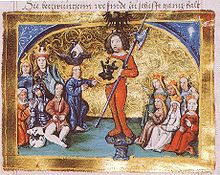Svarožić

Svarožić [ ˈsvarɔːʒitɕ ] is a Slavic god who was known by different names in different areas. With the East and South Slavs it was called Dažbog or Dabog , with the Elbe and Baltic Sea Slavs it was later called Radegast or Redigast , Czech . Radhošt .
Name and position
The name Svarožić can be interpreted as the "son of Svarog ", the sky god and god father of the Slavic pantheon . In the early days, the son of Svarog was considered the god of earthly fire and light , i.e. the sun god and giver of life. The syllable dažd ("give") of his other name Dažbog also indicates this giving function . He was therefore especially revered in the agricultural sector, on the occasion of solstices . With the Elbe and Baltic Sea Slavs, Svarožić was later given the function of a war and tribal deity.
Cult among the Eastern and Southern Slavs
In the east of the Slavic region the deity was worshiped as part of a fire cult . Prince Vladimir I introduced his cult in Kiev in 980 : Dažbog was one of the six gods, along with Perun , Stribog , Chors , Simargl and Mokosch , whose idols were erected in the city, but were demolished eight years later after Vladimir's baptism . “Svarožić” was also the name of the cultic fire itself in Russian treatises of the 11th and 12th centuries; the Ipatejev annals from the beginning of the 12th century compare him to the Greek sun god Helios . Even in the 12th century called Igor's the whole Russian people and its princes Oleg, the "grandson Dažbogs".
In the southern Slavic area, among the Bulgarians and Serbs , Dabog is also associated with a fire cult. As the son of Dabog, the young god Božič was worshiped in a burning trunk at Christmas. With Christianization, Dabog was equated with the devil . The Gnostic Christian group of the Bogomils confronts him as the “ tsar on earth”, ie as the devil, with the “God in heaven”. This transmission can also be found further north: Bruno von Querfurt names him in a letter to Emperor Heinrich II. Zuarasiz diabolus .
Cult among the Elbe and Baltic Sea Slavs
Svarožić as god of the Elbe and Baltic Sea Slavs is first mentioned at the beginning of the 11th century. In addition to the message from Brun von Querfurt, the account of the chronicler Thietmar von Merseburg should be mentioned, who describes in detail the temple and the cult of the deity at Radegast Castle in the Redarian tribal area . The place was probably identical to the main temple of the tribe, later called Rethra . The priests of Svarožić performed oracles and sacrificial rituals, including human sacrifices, in the richly decorated sanctuary equipped with wooden statues, and tributes from neighboring tribes and spoils of war were also kept in the temple. The cult also included a holy horse and a holy boar, who wallowed in the mud of the lake when war was threatened.
At the end of the 11th century, Adam von Bremen describes a temple called Rethra located on an island castle. The castle has nine gates and is only connected to the mainland by a wooden bridge. The temple is dedicated to several gods, but above all to the main god Redigast. Here the name of the castle seems to have already passed on to the god. This reflects the transformation of the original sun god Svarožić into a local and tribal god. The development of Svarožić to Radegast can be traced by keeping the symbolic animals of the ancient sun cult, horse and boar . Parallels can be found in the institutionalization of other cults of the Northwest Slavs , such as the cult of Svantovite on Rügen. The later chroniclers Helmold von Bosau and Saxo Grammaticus endorse Adam's description and add further details.
Svarožić, who had become a Radegast, took on a different field of activity than before: As a protective tribal god, he became the Redarian god of war . With the increase in their influence within the tribal group of the Liutizen , its importance also grew. After all, according to Helmold, the Abodrites should also have recognized him, and Radegast was also venerated in Cape Arkona on Rügen. The head of Bishop John was sacrificed to him in Rethra in 1066 , but the sanctuary was destroyed as early as 1068 . Radegast's leading religious role was taken over by Svantovit as the tribal god of the Rans for another hundred years .
Modern reception
A modern statue of Radegast stands near Pustevny on the ridge of Radhošť in the Western Beskids. The sculptor Albín Polášek created this sculpture, cast from artificial stone, in 1930. A granite copy has stood in the same place since 1998, while the restored original has found a protected location in the town hall of Frenštát pod Radhoštěm .
The asteroid of the inner main belt (2581) Radegast was named after the deity.
literature
- Zdeněk Váňa: Mythology and gods of the Slavic peoples (original title: Svět slovanských bohů a démonů ). Urachhaus, Stuttgart 1992, ISBN 3-87838-937-X -
Web links
Individual evidence
- ^ Lutz D. Schmadel : Dictionary of Minor Planet Names . Fifth Revised and Enlarged Edition. Ed .: Lutz D. Schmadel. 5th edition. Springer Verlag , Berlin , Heidelberg 2003, ISBN 978-3-540-29925-7 , pp. 186 (English, 992 pp., Link.springer.com [ONLINE; accessed on 23 August 2019] Original title: Dictionary of Minor Planet Names . First edition: Springer Verlag, Berlin, Heidelberg 1992): “1980 VX. Discovered 1980 Nov. 11 by Z. Vávrová at Kleť. ”